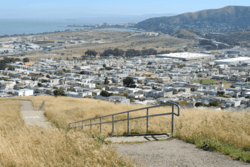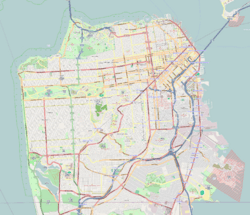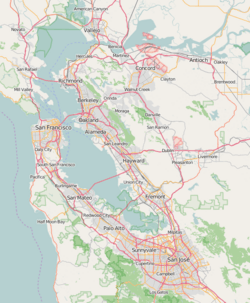Visitacion Valley, San Francisco facts for kids
Quick facts for kids
Visitacion Valley
|
|
|---|---|

Visitacion Valley viewed from Visitacion Ave is Mansell St by John McLaren Park.
|
|
| Nickname(s):
Viz Valley
|
|
| State | California |
| City | San Francisco |
| Area | |
| • Total | 1.582 sq mi (4.10 km2) |
| Population
(2008)
|
|
| • Total | 22,534 |
| • Density | 14,241/sq mi (5,498/km2) |
| Time zone | UTC-8 (PST) |
| • Summer (DST) | UTC-7 (PDT) |
| ZIP Code |
94134
|
| Area codes | 415/628 |
Visitacion Valley (VIZ-i-TAY-shən), often called Viz Valley, is a neighborhood in the southeastern part of San Francisco, California. It's a busy area that blends into Daly City because its streets cross the border between San Francisco and San Mateo County. Part of the Cow Palace event center is also located here.
Visitacion Valley is surrounded by some key landmarks. To the west, you'll find McLaren Park and Gleneagles Golf Course. Mansell Boulevard and Portola are to the north. To the east are Bayview Hill and Candlestick Cove. The southern edge of the neighborhood is the border between San Francisco and San Mateo County.
Contents
What's in a Name?
Visitacion Valley gets its name from a very old land grant called Rancho Cañada de Guadalupe la Visitación y Rodeo Viejo. This large piece of land also included areas that are now part of Daly City, Brisbane, and San Bruno Mountain.
The word "Visitation" comes from a story in the Bible. It describes a special visit when Mary, who was pregnant with Jesus, went to see her cousin Elizabeth. Elizabeth was also pregnant with John the Baptist. The story says that John moved inside Elizabeth's womb when Mary arrived, recognizing Jesus's presence.
Life in Visitacion Valley
Visitacion Valley is mostly a family-friendly neighborhood where many people have jobs that are part of the working-class. This means that many residents work in jobs that involve manual labor or services. The average income in the area is lower than the city's average. Rent prices are also generally lower than in other parts of San Francisco.
A Changing Community
The neighborhood was first settled by immigrants from Ireland and Italy. They often worked in nearby factories. During World War II, many African Americans moved to the area to work in the Hunters Point Naval Shipyard. Some of them lived in the Sunnydale Projects, which were built as temporary housing for workers. After the war, more African Americans moved here from other San Francisco neighborhoods like the Fillmore District and the Western Addition. This was because new housing programs offered affordable places to live.
Today, about 30% of the people in Visitacion Valley are African American. However, this number has been changing as the cost of living in San Francisco goes up. Many Black residents have moved to the East Bay area. Now, more than half of the neighborhood's population is made up of Chinese immigrants.
Housing and Development
The Sunnydale Projects, located on Sunnydale Avenue, are the largest public housing area in San Francisco. They were originally built as barracks for workers.
Another important housing project was the Geneva Towers. These tall apartment buildings were built in the 1960s as private homes. In the 1970s, they became public housing. Over time, the buildings became run down and had many problems. The city decided to tear them down in 1998. They were replaced with smaller, lower-density homes.
The area around Leland Avenue and Bayshore Boulevard is undergoing a big change. This area, including the old Schlage Lock Factory, is being redeveloped. A new project called the Visitacion Valley TOD Project is being built here. TOD stands for "transit-oriented development," which means it's designed to be close to public transportation. This project will include a grocery store, new homes, parks, and other features to help improve the neighborhood.
As more Chinese American residents have moved in, new businesses have opened on Leland Avenue. This street also hosts the Visitacion Valley Street Fair, which started in the mid-2000s.
Getting Around and Learning
A new public transportation line, the T Third Street of the Muni Metro, now serves the neighborhood. It ends at Sunnydale Station. This extension is part of a larger plan to connect this area to the northeast part of the city. This makes it easier and faster for Chinese residents to get to Chinatown.
The San Francisco Public Library has a branch in Visitacion Valley. The old library was a small storefront. A newer, larger library building was completed in 2011 on Leland and Rutland.
Education
Visitacion Valley has several schools for young people.
Elementary Schools
- Visitacion Valley Elementary School
- El Dorado Elementary School
Middle Schools
- Visitacion Valley Middle School
- Our Lady of the Visitacion School (which serves students from kindergarten through 8th grade)
Notable People from Visitacion Valley
Some well-known individuals have lived in Visitacion Valley:
- Peter Hardeman Burnett – He was the first governor of California, serving from 1849 to 1851.
- Rikishi (Solofa F. Fatu Jr.) – A famous American professional wrestler.
- Dan White – A San Francisco supervisor who was involved in the assassinations of Mayor George Moscone and Supervisor Harvey Milk in 1978.
Images for kids









